In August, I shared (in this blogpost) how Tonka was moving when I rode him. Instead of clear two and three-beat gaits, with moments of suspension, Tonka was altering his strides so that he didn’t put his full weight on his hocks and stifles. He was also moving so that he wouldn’t have to use the base of his neck for balance.
It was unclear if Tonka was going like this because of permanent issues with his sacroiliac joint, hocks and neck. It’s not like he was in constant pain. Tonka was perfectly content going for walks and doing easy ring work, but anything that required athleticism was more work than joy. Horses are creatures designed to move. Left to themselves, most of the moving that they do is head-down moseying along while grazing, (which can add up to many miles a day), but they’ll also have a gallop, or float around at the trot, for the sheer fun of it. I had a thoroughbred mare who’d gallop off and jump things in a field just because. I didn’t know if I could get that feeling under saddle from Tonka, but at the least I wanted him to feel that good when turned out.
The “fix” would be multi-pronged. Two months ago, my veterinarian injected his neck to lubricate the vertebrae that are a tad jagged. With that pain relief, I’d be able to up the workouts designed to strengthen the muscles in his stifle and over the SI joint. We walked up and down hills, then cantered them. We did exercises over poles, and then raised cavalletti. When doing our dressage schooling, I slowly changed his head position from long and low to up, with an arc through the neck.
The other day, I let Tonka loose in the sand ring to check on how he felt.
He started out with an eager look. What did I want?

I asked him to show me what he had. Note that I didn’t carry a whip or scare him into moving. It just required a chirpy “go.” Once he’s moving, I don’t do or say a thing. Here’s a slo-mo response.
The joy is back.
This is the moment that he pushes off from walk to trot. He’s got those topline and core muscles engaged.
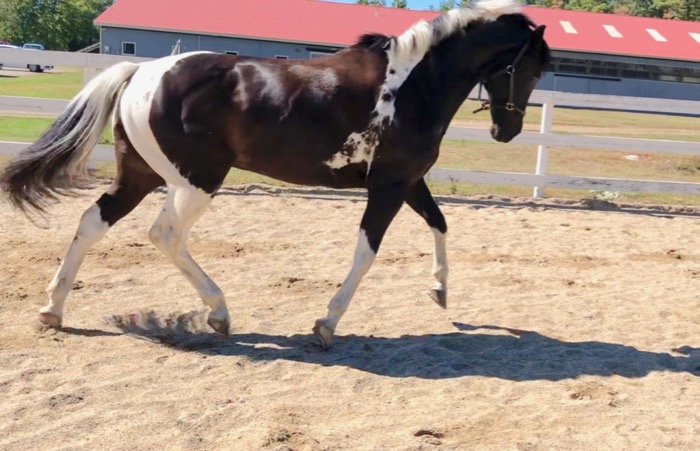
Tonka floats with his head up (he’s checking out something outside of the ring.) A month ago, those hind toes were dragging in the sand. Not now.
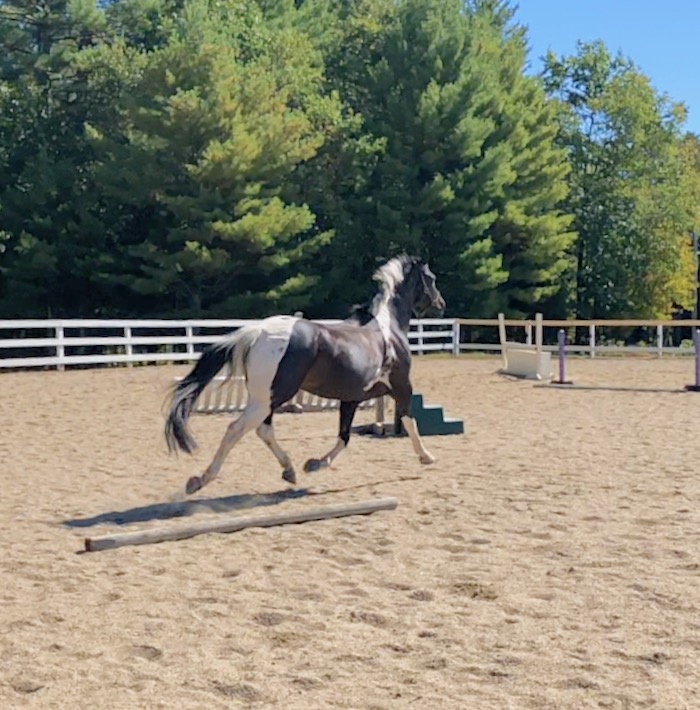
Tonka floats with his nose down. He’s articulating those hock joints without a hitch.
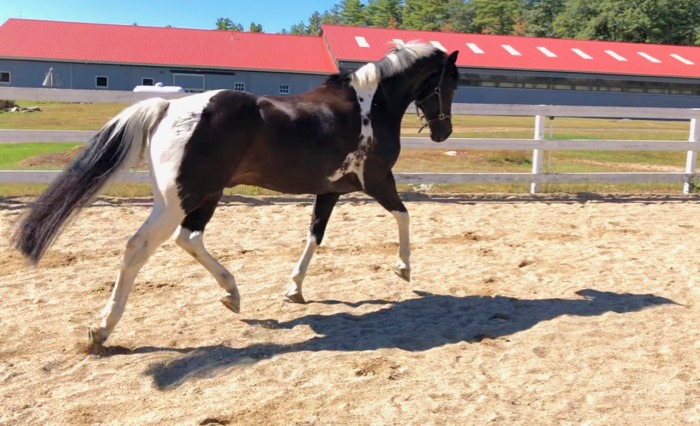
Look at that suspension.
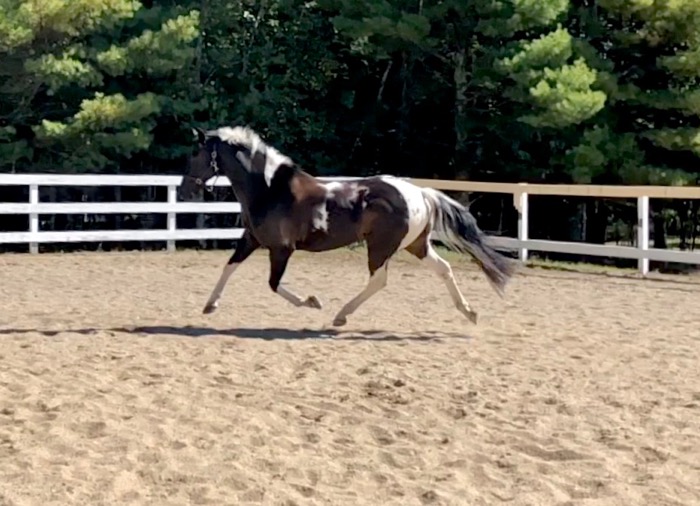
The canter has always been an awkward gait for him. When I got Tonka, he’d switch behind, and get all discombobulated. He had no stamina at the canter, and it always felt downhill.
This is the opposite of downhill.

I think Tonka now feels like he can fly.
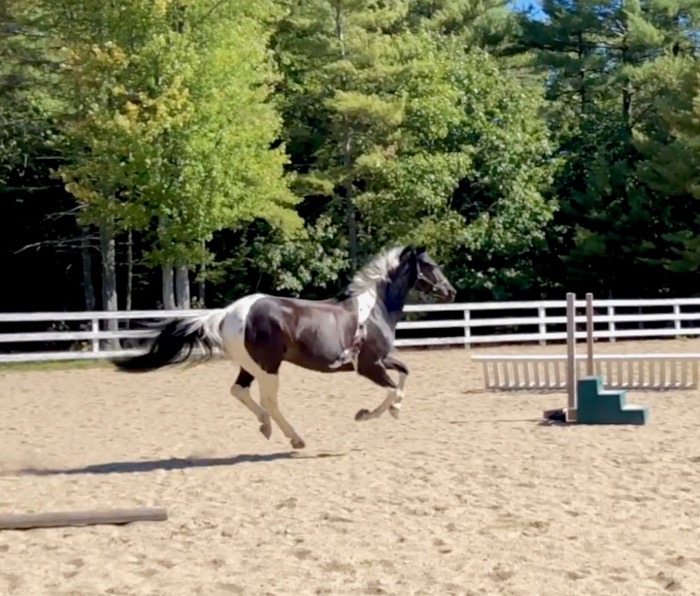
When I get on, Tonka isn’t quite so light on his feet. I’ll be writing about how I’m going to improve my riding so that I don’t interfere with those glorious moments of suspension. There are numerous components to be addressed, but one of them might be going to a gym. I need to have my core strength match my horse’s!
Do you work out so that you can be a better rider? Let me know in the comments.
Here are two more photos. Eye candy.
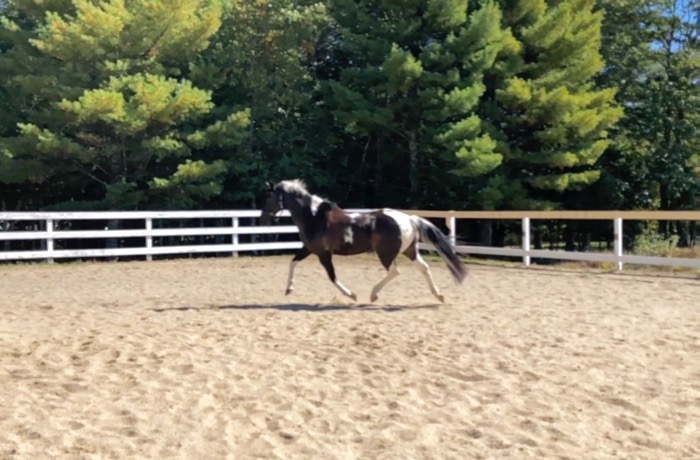
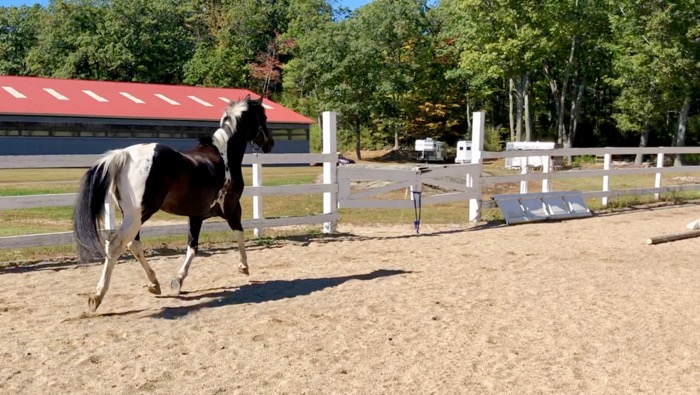


Wow, look at Tonka’s new skills! He shows the kind of strength, collection, and extension that a dressage horse does. And isn’t it fun for the horse, with and without a rider! Awesome.
Saturday morning I was out at the barn with Gale Pryor, enjoying watching her ride. Her instructor, Debby Baldelli, had been away in Europe and just returned. Gale and Debby were now wearing ear pieces, enabling them both to talk back and forth without having to shout the length of the ring.
In the course of the hour, the sweet and relaxed horse that Gale was riding brought himself together, arched his neck, balanced on small and large circles, and showed suspension and a flashy extended trot, a thrill for rider and horse too.
It’s great what a rider can do with a horse, using his or her own body moves and mutual understanding, without pulling the reins around unnecessarily.
I also use a listening system with my instructor and when I teach. Even if you’re using the same words, not having to yell creates a much nicer tone to the lessons.
As you know, you and I have horses with some similar issues, so Toka’s story feels so familiar. I’ve always used cavalletti and trotting poles as part of our routine, as well as hacking out and walking/trotting/cantering hills. My mare has grown stronger and stronger with correct work and gymnastic exercises and just recently I have had to put bell boots on her because she has moved to a stage where her hind end is stronger than before and she is trotting so far under herself that she’s forging. It’s a stage, my trainer says, and she’ll be able to forgo them once she figures out how to get her front legs out from under her when she’s got a rider on board.
I subscribed to Dressage Rider Training for a while and got some benefit from that in terms of fitness and strength, as well as taking yoga classes from my daughter. But most recently I’ve started taking Pilates using the Reformer machines and …. WOW! If those machines don’t show you every spot where you’re crooked or weak, I don’t know what will. And as I grow more aware of my own weak spots, my riding is getting better and better. Having the right teacher for the Pilates class helps, too. He has worked with dressage riders before and is very tuned in to what we need to do with our horses. I highly recommend it.
I subscribed
Your comment has given me the final push to get brave enough to call a pilates studio that is within a reasonable driving distance. Thanks!
Also, Toka looks magnificent! You are going to feel like you’re flying when he does that with you on board. So lovely to see his journey play out like this. I have hope for my mare and I in the dressage ring now!
Yes, so much eye candy! I’m thrilled for both of you!!!
Wonderful!
I admit I got just a tiny bit teary, seeing Tonka looking so great!
Me too 🙂
Several people that I know work out on a regular basis so that they remain strong enough to ride. I try to get 10,000 steps a day , as well as exercise. However, the trainer at our barn rides so much that he doesn’t need to work out. It takes a lot of strength to keep up with a horse, and it is all in our core..
One woman that I’ve trained with rides multiple horses daily, has a “real” job, and goes to the gym at 6 am in order to be fit enough to ride with finesse. I don’t have that drive, but I am going to do something.
I pretty much stopped riding a mountain bike to try to avoid confusion between the elbows-up hips forward “good” position on a bike and the desirable positions on a horse. I do more underwater swimming with a dolphin kick now to try to keep my core in better shape for riding.